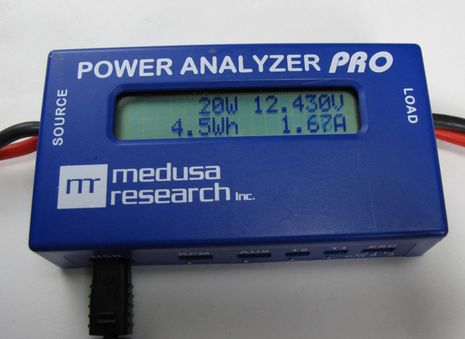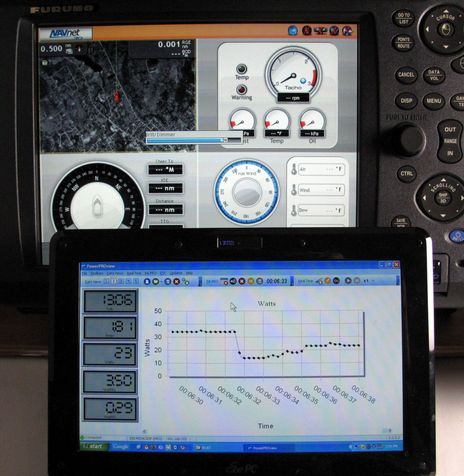Medusa Power Analyzer Pro, & some results
The average boater doesn’t need a power analyzer like this, but battery scrooges and testers like me might be interested. This Medusa Research Pro is actually designed for radio control hobbyists but its features and value appealed to my inner geek, and so far I’ve been really pleased with what it can do…
 The Medusa, you see, is not only a stand-alone meter but it also has a USB port and comes with a recording and analyzing program. In the shot above I’ve been recording the power draw of a Simrad NSE12 for a several minutes but a few seconds before had turned the screen from full brightness down to about 3 and then back up to 7. As you can see in the 8 seconds graphed it uses 34 watts at full 10 and 25w at 7. Interestingly, the Furuno MFD12 below showed very similar numbers, though the NSE is backlit with LEDs. What I can’t measure, unfortunately, is screen brightness. Both of these are quite bright, though I think the NSE is a little more so and seems to have slightly richer colors (but that’s subjective).
The Medusa, you see, is not only a stand-alone meter but it also has a USB port and comes with a recording and analyzing program. In the shot above I’ve been recording the power draw of a Simrad NSE12 for a several minutes but a few seconds before had turned the screen from full brightness down to about 3 and then back up to 7. As you can see in the 8 seconds graphed it uses 34 watts at full 10 and 25w at 7. Interestingly, the Furuno MFD12 below showed very similar numbers, though the NSE is backlit with LEDs. What I can’t measure, unfortunately, is screen brightness. Both of these are quite bright, though I think the NSE is a little more so and seems to have slightly richer colors (but that’s subjective).
At any rate, this gadget will be useful for testing LEDs, whose manufacturers may be tempted to exaggerate their efficiency. I’ve also already noticed some cases where displays like the Simrad AI50 use considerably less juice when turned down just one notch. I bought the Medusa from PowerWerx with the PowerPole connectors I use already attached and while they don’t seem to carry it anymore, they do offer two similar if less geeky meters. And for some less exotic electrical measurement tools, do check out Dan’s list.















I just went to the Medusa Research website, went to their Order page to check on pricing and was met with “WE ARE NO LONGER SELLING ANY PRODUCTS”.
No further info or explanation, nor any mention that they’re giving them away instead of selling them .
Looks like they had excellent product though. With a large battery bank, it would be quite handy to be able to remotely monitor battery state down to the cell level.
Any other options to consider?
Nice unit… too bad they’re not selling it anymore.
Here’s a very similar unit I use to measure the voltage and current from each PV Panel in my PV array aboard LIONHEART
http://www.rc-electronics-usa.com/ammeters/rv-battery-monitor.html
Well, that’s embarrassing, and sort of sad, but it sounds like the story isn’t over. When I went to the Medusa site yesterday I thought they’d just stopped selling direct, but in fact they are completely out of the RC business. (On some RC forums they say it’s because of competition from China.)
However, I just called the number listed under Tech Support and was told that they are about to restart production of the Power Analyzers. The man, who sounded like the owner of Medusa, said that this will happen “in the very near future” and new will be posted on the Medusa site:
http://www.medusaproducts.com/index.htm
Hah! Simrad saw the pictures and passed this along:
Published screen brightness for MFD12 is 1100 cd/m2 and NSE published screen brightness is 1500 nits. (1:1 cd/m2 to nits). The advantages of LED backlit displays vs. CCFL are numerous.
* LED consumes less power. CCFL requires DC to AC power conversion to illuminate a complex series of fluorescent lights, LEDs are DC driven solid state devices that consume less power during use
* On average, an LED can generate 30% more white brightness than a CCFL tube.
* LED provides maximum brightness from time zero [sic]; CCFL tubes, much like their home/office cousins, have a warm-up period before reaching maximum brightness� during this period of warm-up the CCFL can consume 50% more power
* LEDs have a longer life than CCFL and also do not suffer from fluorescent exhaustion, or end of life where they burn � as bright as when new� every hour a CCFL unit is on, its brightness is decreasing
* CCFL tubes also contain toxic Mercury; although recent levels have decreased through advances in CCFL design, performance has also diminished. CCFL designs are not as environmentally friendly as LED
* Because added hardware components are needed, CCFL designs increase the overall platform dimensions
* Some CCFL units we�ve tested have internal fans and temperature feedback. After 2 hour warm up, luminance reduced to 1180 nits on a competitors unit, the Simrad unit was 1500 nit.
* NSE LED Rails are optimized to maintain 80% lumen maintenance with LED Ta=80C
* LED output actually increases at low temperatures, while low temperatures severely impact CCFL
Ben,
This is interesting as far as the display comparison goes.
If the one is much more efficient why is the power draw so close or even lower on the Furuno? I saw both at a dealer and couldn’t detect or see the brightness difference. The dealer also said the Furuno had been running everyday in his Showroom for almost two years!! Based on the above, I would have expected to notice some difference. I personally really like the raster chart colors and scrolling on the Furuno mfd12.
Ben H
Ben,
Would a simple lux meter that photographers use be enough to gather a numerical value for brightness readings across brands?
Gentlemen,
I am currently looking for a Power Analyzer Pro or a similar product that will allow me to export data to my PC.Is anyone aware of such a product? It will make my like way easier at the moment
Please let me know
Thank you!
K